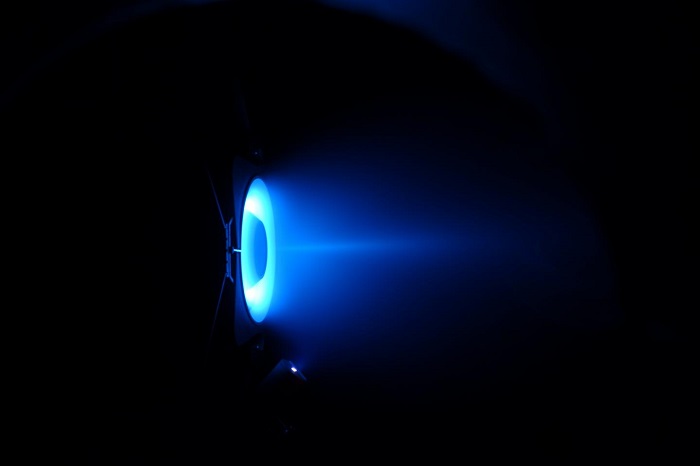In short, Hall thrusters are electric rocket engines that use a high-speed stream of plasma to push spacecraft forward.

Up until just recently, this technology was used to make slight adjustments to a spacecraft’s flight path. It’s since been applied to two satellites for the purpose of powering their voyage entirely.
There are a bevy of things worth taking a closer look at when it comes to this technology; chief among them is fuel consumption. A Hall thruster actually uses 100 million times less fuel propellant than conventional chemical rockets. As such, this technology is being heavily explored as a candidate for such deeper space expeditions as exploring Mars, asteroids, and the outermost edges of the solar system.
The problem with Hall thrusters, however, is its lifespan — the current life of this technology is around 10,000 operation hours which is way too short for most space explorations (most require at least 50,000 hours).
In an attempt to remedy this situation, researchers from the French National Center for Scientific Researcher have come up with a new type of Hall thruster — one without walls.
The basis of their thinking lies in the Hall thruster’s operating principle; that is, the fact that this technology relies on the creation of a low-pressure quasi-neutral plasma discharge in a crossed magnetic and electric field configuration (xenon, which is typically the propellant gas, is ionized by electrons trapped in the magnetic field).
In your A-typical Hall thruster, the magnetized discharge gets confined to an annular dielectric cavity with the anode at one end (where the gas is injected), and an external cathode on the other end (where the electrons are injected). Ionization occurs inside the cavity, with ions accelerated by the electric field that stretches from the inside to the outside of the cavity. It’s effective, but not without its issues.
“The major drawback of Hall thrusters is that the discharge channel wall materials largely determine the discharge properties, and consequently, the performance level and the operational time,” explains Julien Vaudolon, the primary researcher in the Electric Propulsion team led by Professor Stéphane Mazouffre in the ICARE-CNRS Laboratory, France. Vaudolon says that the wall materials influence the plasma properties mostly through secondary electron mission. This is seen as somewhat of an extraordinary occurrence because when the high-energy ions hit the channel wall surface, it induces the emission of secondary electrons.
What’s more, this constant bombardment, if you will, leads to the erosion of the cavity walls which, in turn, leads to a shortening of the thruster’s lifetime.
“Thus, an effective approach to avoid the interaction between the plasma and the discharge channel wall is to move the ionization and acceleration regions outside the cavity, which is an unconventional design named a Wall-Less Hall Thruster,” Vaudolon said.
Work began on a wall-less Hall thruster many, many months ago, and a small working prototype was achieved last year. What the team did at first was move the anode to the channel exhaust plane. Doing this didn’t produce much power, as the magnetic field lines are perpendicular to the thruster axis, which cross the anode placed at the channel exhaust plane.
“Magnetic fields are used to trap hot electrons injected from the external cathode and prevent them from reaching the anode,” Vaudolon said. “Basically an electron travels along the magnetic field line. If the magnetic field lines cross the anode, a large portion of hot electrons will be collected at the anode and won't take part in the ionization of the xenon atoms, resulting in high discharge current, low ionization degree, and consequently, low performance level.”
To help the magnetic lines avoid the anode surface, the team rotated the magnetic barrier 90 degrees. Doing this allowed it to inject the magnetic field lines parallel with the axial direction. The anode was still at the channel exhaust plane, but its shape was curved so as to avoid any possible interaction with the magnetic field lines.
Based on these adjustments, a 1.5 kilowatts class thruster has so far proven effective in lab tests, yielding what the team described as “satisfactory” performance.
Despite the team’s success in this regard, Vaudolon explained further optimization is still needed for the thruster’s efficient operation at high power.
“The wall-less thruster allows scientists to observe regions of the plasma previously hidden behind the channel walls. Now the plasma region can be observed and diagnosed using probes and/or laser diagnostic tools,” he said. Vaudolon also pointed out that the access to key regions of the plasma will allow for a more thorough investigation of plasma instability and small-scale turbulence which, in turn, will provide his team a better understanding of the discharge physics and anomalous electron transport.
“Despite decades of research, the physics of Hall thrusters is still far from being understood, and the device characterization methods still rely on trials and testing, leading to expensive efforts,” Vaudolon said. “The major difficulty in developing predictive simulations lies in modeling the interaction between plasma and wall. The wall-less design would be an effective solution, potentially making future predictive simulations feasible and reliable.”
The team plans to next work on designing a dedicated wall-less Hall thruster to further explore the possibilities of this special architecture.
To learn more, check out the group’s paper, entitled “Optimization of a wall-less Hall thruster”.
Via EurekAlert
Advertisement
Learn more about Electronic Products Magazine





